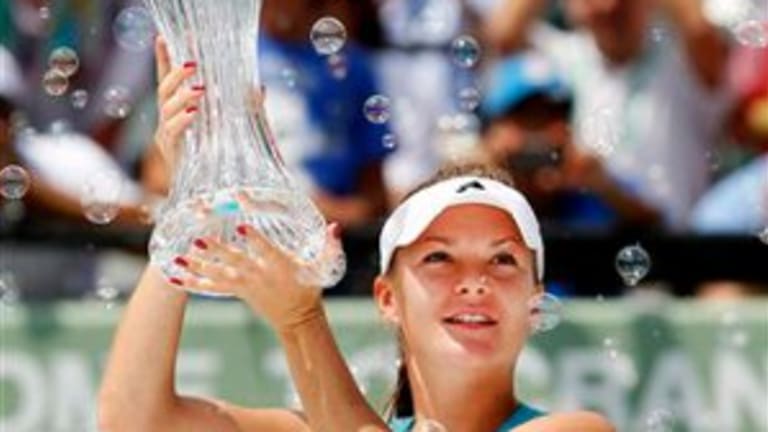* !Pic
by Pete Bodo*
MIAMI—She plays in so lackadaisical a manner as to appear apathetic. On the rare occasion when she hits an ace, it’s apt to be traveling at 81 MPH—not quite enough to shatter the sound barrier. Her signature shot is a backhand or forehand that she strikes while squatting, often in danger of falling over backward, like a little girl losing her balance while building a sand castle.
Agnieszka Radwanska is the slow-acting poison of the WTA, and she claimed one of her most surprising victims today, mastering world No. 2 Maria Sharapova in the final of the Sony Ericsson Open, 7-5, 6-4. It was her first win over Sharapova in their last seven matches, and the best title Radwanska has earned to date.
It was a convincing win built on Radwanska’s ability to mesmerize and frustrate a woman with a game more typically of our time. Some pundits will say that Radwanska is “old school,” or describe her as a throwback, but that’s not quite accurate. There have always been women players who relied on power and athleticism, and there have always been some who were more inclined—or compelled—to cultivate guile and variety.
Like Martina Hingis, the player who Radwanska admires and whose sensibility she most closely mirrors, the Pole's competitive poise is a frequently overlooked factor in her success (she’s climbed to No. 4 in the world).
Today it was just as critical part of the winning formula as her lack of unforced errors (10, to Sharapova's 45) or a service-return match-up that turned the conventional wisdom on its ear. Wasn’t this match supposed to be about how vulnerable Radwanska is to an aggressive returner?
I had the chance to sit down with Radwanska long after she finished her official presser and the rest of the champion’s media obligations. She was on her second post-match outfit, a lacey, low-cut white top with spaghetti straps, Daisy Duke shorts, and flip-flops.
“It was weird,” she said, looking back on the match. “In my semifinal with Marion (Bartoli) it was all breaks—I’m not sure she even won her serve one time. The return was the key. Today, the serve was the key. I didn’t lose my serve one time and that’s why I won the match.”
That was no mean feat against a woman with the aggressive return of a Sharapova, and the statistics are telling. Radwanska put 70 percent of her first serves into play, just one percentage point better than Sharapova. But she won 76 percent of those first-serve points, while Sharapova won just 67 percent of hers.
“In a match with so few breaks, you just have to be a few percent better,” Radwanska told me. “I just break her in the last game of each set. I closed it out well, because if would go to three sets maybe I would be in trouble because she is very aggressive—always putting pressure.”
Sharapova tried to apply that pressure throughout the match, but Radwanska resisted it admirably. The Krakow native (she still lives there, and attends classes at a local university when she’s at home) doesn’t tag scorching serves, shriek in ecstacy as she hammers a forehand, or shake a menacing fist at the tennis gods (or the player guest box) after every winner. She’s cool to the point of seeming uninterested, and betrays not a smidgen of emotion. Her step is light and she wastes no energy on preparatory rituals. “Anger,” she said. “is just wasting energy. Better to look ahead to something positive, the next point.”
